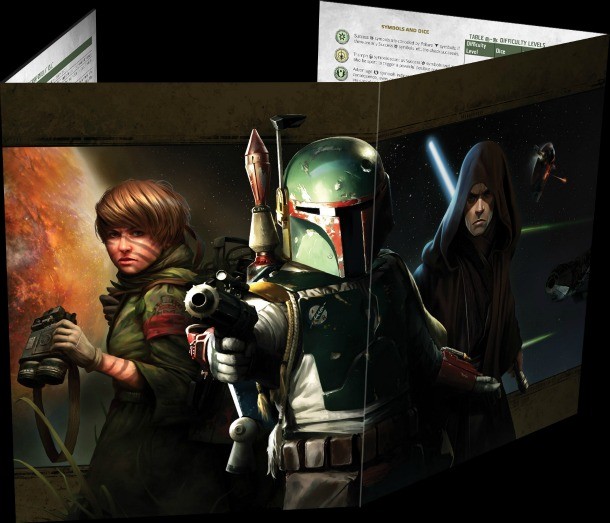Please support Game Informer. Print magazine subscriptions are less than $2 per issue
Top Of The Table – Star Wars: Edge Of The Empire

In the last couple of months, we’ve been highlighting some great games to share with the family over summer break in the form of Dixit and The Adventurers. This month, our tabletop coverage is steering in a different direction with our look at Fantasy Flight’s new tabletop role-playing game in the Star Wars universe. Unlike other board games we’ve covered like A Touch of Evil or Star Trek: Fleet Captains, Star Wars: Edge of the Empire is a pure RPG, akin to games like Dungeons & Dragons, Pathfinder, and Shadowrun.
Fantasy Flight has crafted a brand new role-playing system built to reflect the best elements of the Star Wars fiction, with a focus on the characters living at the edge of civilization, running in the lawless and dark corners of the galaxy. Edge of the Empire utilizes an innovative core game mechanic built around a set of custom dice, and a character builder that lets players shape a fascinating collection of bounty hunters, explorers, smugglers, and more.
Getting Started
Like most RPGs, Edge of the Empire requires one person to adopt the role of game master to shape the narrative and run the game, and everyone else steps in as a single character within the Star Wars universe – usually 2 to 6 players in total. Players and the GM cooperate to tell the story, and an innovative dice-rolling mechanic not only determines the results of actions, but also helps to add a narrative sense of how those actions unfold.
The Star Wars fiction is an unwieldy beast, and Fantasy Flight has chosen to separate its role-playing game into separate themed experiences. Edge of the Empire (the first release in the line) focuses on characters living on the fringe, far from the Galactic War shaking the Empire and the struggles between the light and dark side Force users. Later installments will add in new content that details those other branches of the Star Wars universe.
Edge of the Empire requires that your group (or at least one or two members of your group) get a hold of the mammoth 400+ page core rulebook, which includes everything from character sheets for photocopying to details on all the rules needed for both players and GMs. In addition, you’ll need to pick up a set of Fantasy Flight’s custom Star Wars dice, which are required to play. Alternately, a Star Wars dice app is available on your smartphone – but frankly, you lose a little something without the fun of real dice rolling on the table. Unlike some role-playing games, Edge of the Empire does not require miniatures or tactical grid maps.

Theme and Story
The designers have done a remarkable job shaping a game that caters to the seedier side of Star Wars, and their efforts bear fruit in the way mechanics, character creation, and story tie together into a unified whole.
The integration of mechanics and story begins as soon as you start to build a character. Before even finalizing a choice of species or career, players select an obligation. Out here at the edge of civilization, a character rarely gets where he or she is without having to make some shady decisions, and obligations help to represent these choices. Think of Han Solo’s debt to Jabba the Hutt, or Boba Fett’s connections to his father and his desire for revenge. Players select an obligation before play begins, and those narrative threads loom over subsequent game sessions; every obligation has a numerical value, and a check at the beginning of each gameplay session determines if the party’s obligations will come into play. Players can accept additional obligations before the game begins to get extra XP or credits to help build their character, but in so doing they risk their obligation becoming a more central threat within the storyline.
I love the risk/reward quality that obligations bring into the role-playing experience, and the narrative implications assure that every character begins play with some fun challenges to face.
The rest of character creation is built around high customizability. The game details eight different species, each with their own special bonuses. My favorite inclusion is the option to play a droid, albeit with a few structural differences from organic creatures, like the inability to become a Force sensitive.
Players then select one of six careers: bounty hunter, colonist, explorer, hired gun, smuggler, or technician. Each career comes with the choice of three specializations, like the smuggler’s choice of pilot, scoundrel, or thief. A specialization brings with it an intriguing branching -style talent tree, so you can build just the character you want.
When you stack the flexible character build options with the rich collection of information provided on the seedy underbellies of the galaxy’s worlds, Edge of the Empire bristles with opportunities for storytelling.
[Next up: The awesome dice mechanic at the core of the game]

Gameplay
The core mechanic of Edge of the Empire, and the feature that sets it apart from other RPGs, involves its unique narrative dice and dice-rolling system. Through the system, players learn not only whether a character succeeds or fails at an action, but also gains narrative insight into how they succeed or fail.
The required custom dice are split up into positive and negative dice types, and a third die type that represents the Force. Players gain positive dice for having abilities and proficiency for the task at hand, along with special boost dice for particularly favorable circumstances. Negative dice represent the difficulty of a task, the challenge of dangerous opposition, and setbacks that might make the action more complicated. Finally, the occasionally used force die generates light side and dark side resources that can be spent for special effects.
Any single important action involves rolling a number of dice in one go, and compiling the results to find out what happens. If there’s at least one success symbol more than there are failure symbols, the character succeeds at the task. However, the fun part comes through interpreting how a character succeeds or fails. For instance, a character may fire a blaster and miss her target, but an advantage symbol indicates that the blaster bolt destroys the lock on the window that is the only route to escape for the heroes. Alternately, maybe you succeed on your check, but a threat symbol shows up in the results, perhaps indicating that you were forced out of cover to successfully make the shot.
In practice, this system offers tremendous flexibility to allow the players to participate in the storytelling process, rather than just waiting for the GM to respond after a die roll. The players talk together about how to interpret a roll of the dice, and shape the results to make the most exciting story. It also speaks strongly to the cinematic nature of the Star Wars universe; characters in the movies often succeed or fail along with potent side effects. Think about Luke blasting the controls to extend the bridge on the Death Star. Through this system, encounters have increased drama and rich narrative depth.

Complexity
Edge of the Empire has a steep learning curve for the first few hours, but then levels out. The initial challenge comes as the players and GM learn the eight different symbols that can show up on the dice, and furthermore figure out how to interpret them. In addition, new players (and especially GMs) need to become versed in when to add the different dice into a given skill check.
As a result, the temptation is to get bogged down in the early hours of learning with discussions of when to include what dice, and exactly what each result means. Instead, I highly recommend that players new to the game take a more casual approach, using what they understand of the dice results to shape a compelling narrative. The rest comes in time, as well as the myriad ways that gear, talents, wounds, defense, and other factors layer into the experience.
If you’re completely new to tabletop role-playing, rather than dive directly into the intimidating core rulebook, I recommend picking up the Edge of the Empire beginner game, which offers a more catered and instructive approach to learning the system.
[Next up: How much does the game cost? And what about those other upcoming versions of the game?]

What Else Do I Need To Know?
Star Wars: Edge of the Empire’s core rulebook includes everything you need to play except for the dice, with rules for players and GMs, details on several adversaries, and a short adventure to get your campaign started. You’re looking at an initial investment of $59.95, but I’ve found online retailers listing the book as low as $40-45. Alternately, if you want to take the introductory approach, the Beginner’s Game has an MSRP of $29.95, and includes a set of dice.
If you buy the required dice separately, the list price is $14.95, or you can pick up the dice app for $4.99. Finally, for particularly enthusiastic folks, the GM screen runs for $19.95, adding a bevy of tables and info to help run sessions, as well as another published adventure.
You can purchase all of the above directly from Fantasy Flight, or from other online retailers like Cool Stuff Inc. or Amazon. You can also find Star Wars: Edge of the Empire at your local book, comic, or hobby store.
It’s also worth noting that Fantasy Flight already has plans afoot to expand its Star Wars RPG in the coming months and years. The Age of Rebellion game adds in rules related to the Galactic Civil War and the conflict between the Rebel Alliance and the Empire. The Force and Destiny game adds additional rules to further flesh out the Force and the inclusion of Jedi and Sith. All three are cross-compatible. As a result, it’s possible that you could craft a force-sensitive exile character for play in the Edge of the Empire, and when the new sourcebooks release, grow them into a full-fledged Jedi. For more on the way the full Star Wars line will work together, check out Fantasy Flight’s video introduction to the game.
Star Wars: Edge of the Empire is a fantastic starting point for players eager to explore more stories in the rich Star Wars universe. If any criticism can be leveled at the game, it’s that this initial offering restricts things to those criminal and darker edges of the Star Wars galaxy, which some players may find limiting. Nonetheless, there’s plenty of great content to dig into here. The Core Rulebook is smartly written, well organized, and filled with beautiful full-color art. And the unique dice rolling system, while challenging to grasp at first, offers incredible narrative flexibility to a gaming group. If you’ve always been fascinated by the shadier threads of the Star Wars mythology, Edge of the Empire is sure to please.
Looking for more great tabletop games for times when you’re taking a break from the digital gaming world? Check out our looks at Ascension, Tannhauser, Castle Ravenloft, Yomi, Star Trek: Fleet Captains, Agents of SMERSH, A Touch of Evil, Mage Wars, The Adventurers: Pyramid of Horus, and Dixit.










